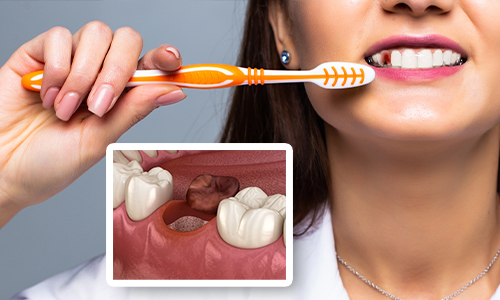How to Avoid Dry Socket After Your Wisdom Tooth Removal?
Dry sockets after wisdom tooth removal can be a painful unavoidable experience that impedes the natural healing of the extraction site. According to statistics, only 2 to 5% of patients are affected. Researchers find that it is more likely to happen after extraction of the lower wisdom tooth than the upper ones and it occurs more frequently in women than in men as estrogen hormones in females dissolve the blood clot.
How to avoid dry socket after wisdom tooth removal? If the patients become aware of the preventive measures to avoid dry sockets and follow proper care after tooth extraction, they can ease their concerns and help with the healing of the surgical site so that they can resume their regular life as soon as possible.
Patients can ease their concerns and help with the healing of the surgical site if they are aware of the preventive measures to avoid dry sockets and follow proper care after tooth extraction.
Continue reading to learn about dry sockets, their causes, and how to avoid a dry socket after wisdom teeth extraction.
What Is A Dry Socket?
A socket is a hole created in the jawbone where the roots of the tooth used to be after the tooth is lost or extracted. This hole heals naturally overtime when a blood clot, which appears like a dark-colored scab, forms in it and covers it completely.
A dry socket, medically known as alveolar osteitis, is a condition of the wisdom tooth socket that occurs when a blood clot either does not form at all or is dislodged/damaged after the tooth extraction in the empty socket. Because no proper blood clot forms, the bones, and nerves of the socket are exposed to the oral environment, which includes air, food, and bacteria. Consequently, dry sockets appear white.
How to know if you have a dry socket after wisdom tooth extraction? Patients who suffer from dry sockets exhibit symptoms such as dry opening in the place of the blood clot, bad-smelling breath, tenderness, a foul taste inside the mouth, and most notably, extreme throbbing pain that may radiate to the ears, head, or neck. These signs/symptoms are usually noticed about 2 days after wisdom tooth extraction.
What Causes Dry Socket?
A dry socket can occur as a result of anything that displaces the blood clot formed in the tooth socket before the site heals or as a result of the thrombocytes failing to clot the blood at the wounded site of the mouth. Its common culprits include-
- Chemical- Smoking cigarettes or any other product can prevent blood clot formation. Nicotine present in them can reduce the amount of blood inside the mouth, making clotting difficult.
- Bacterial- If the patient already has bacterial infections such as gingivitis or periodontitis at the time of wisdom tooth extraction or poor oral hygiene, the harmful bacteria may dissolve or prevent the blood clot from forming.
- Psychological- This includes internal factors that prevent blood clot formation like reduced blood supply due to old age and hormonal changes that may occur as a result of oral contraceptive pill use in women.
- Mechanical- After extraction, if the precautions are not taken, eating or drinking can dislodge the blood clot. The actions that can also cause it to include drinking through a straw, vigorous rinsing of the mouth, coughing, sneezing, and spitting.
How To Prevent A Dry Socket After Wisdom Tooth Extraction?
Ways To Prevent Dry Socket:
- Avoid Sucking From A Straw- Suction can cause the blood clot to shift out of place. The air passed through the straw and the movement of the mouth can increase the risk of getting dry sockets. So, using straws must be avoided for at least a week after the wisdom tooth extraction.
- Refrain From Smoking- Researchers have found that smokers are 12% more likely to develop dry sockets than non-smokers. Tobacco or nicotine chewing gum use can disrupt the natural healing process and should be avoided weeks before and after the tooth extraction.
- Have A Proper Diet- After wisdom tooth extraction, your diet must contain soft, chewable foods rather than crunchy, hard, tough foods for at least the first week. Warm and carbonated beverages must not be consumed. These foods or drinks can dislodge the blood clot or stick in its place, resulting in pain while eating/drinking.
- Maintain Oral Hygiene- Healthy oral hygiene must be practiced even after tooth extraction which includes gentle daily brushing as directed by the dentist after 24 hours and rinsing the mouth with prescribed antibacterial mouthwash or saltwater regularly. This keeps the bacteria at bay at the site of a blood clot, preventing infection and blood clot dissolution.
- Rinse The Wounded Site With A Syringe- After the blood clots have solidified in their place, which usually takes 5 days, you can gently rinse it with a curved syringe provided by an oral surgeon to remove any trapped food particles.
- Never Schedule Wisdom Tooth Extraction While You Are Sick- If you are sick and sneezing or coughing frequently, wait until you feel better; otherwise, the aggressive mouth motions may dislodge the blood clot or prevent it from forming.
- Have Proper Rest- Wound healing always requires plenty of rest or adequate sleep to allow the blood clot to form and settle in. Hence, after tooth extraction, get plenty of sleep, and avoid physical activities that increase your heart rate.
The best wisdom tooth removal surgeon at The Dental Specialist (TDS), offers expert tooth extractions in Chicago and performs the best surgery to avoid dry sockets formation after wisdom tooth removal. If you believe you may need one or more teeth extracted, contact us online or give us a call to get a comprehensive oral exam and find out the right steps to take to protect your oral health.

